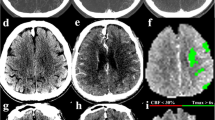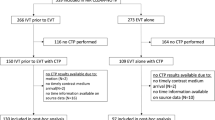Abstract
Introduction
Reliable predictors of poor clinical outcome despite successful revascularization might help select patients with acute ischemic stroke for thrombectomy. We sought to determine whether baseline Alberta Stroke Program Early CT Score (ASPECTS) applied to CT angiography source images (CTA-SI) is useful in predicting futile recanalization.
Methods
Data are from the FUN-TPA study registry (ClinicalTrials.gov; NCT02164357) including patients with acute ischemic stroke due to proximal arterial occlusion in anterior circulation, undergoing reperfusion therapies. Baseline non-contrast CT and CTA-SI-ASPECTS, time-lapse to image acquisition, occurrence, and timing of recanalization were recorded. Outcome measures were NIHSS at 24 h, symptomatic intracranial hemorrhage, modified Rankin scale score, and mortality at 90 days. Futile recanalization was defined when successful recanalization was associated with poor functional outcome (death or disability).
Results
Included were 110 patients, baseline NIHSS 17 (IQR 12; 20), treated with intravenous thrombolysis (IVT; 45 %), primary mechanical thrombectomy (MT; 16 %), or combined IVT + MT (39 %). Recanalization rate was 71 %, median delay of 287 min (225; 357). Recanalization was futile in 28 % of cases. In an adjusted model, baseline CTA-SI-ASPECTS was inversely related to the odds of futile recanalization (OR 0.5; 95 % CI 0.3–0.7), whereas NCCT-ASPECTS was not (OR 0.8; 95 % CI 0.5–1.2). A score ≤5 in CTA-SI-ASPECTS was the best cut-off to predict futile recanalization (sensitivity 35 %; specificity 97 %; positive predictive value 86 %; negative predictive value 77 %).
Conclusions
CTA-SI-ASPECTS strongly predicts futile recanalization and could be a valuable tool for treatment decisions regarding the indication of revascularization therapies.


Similar content being viewed by others
References
Shi Z-S, Liebeskind DS, Xiang B, et al. (2009) Multi MERCI, TREVO, and TREVO 2 Investigators. Predictors of functional dependence despite successful revascularization in large-vessel occlusion strokes. Stroke 45: 1977–1984
Hussein HM, Georgiadis AL, Vazquez G et al (2010) Occurrence and predictors of futile recanalization following endovascular treatment among patients with acute ischemic stroke: a multicenter study. AJNR Am J Neuroradiol 31:454–458
Barber PA, Demchuk AM, Zhang J, Buchan AM (2000) Validity and reliability of a quantitative computed tomography score in predicting outcome of hyperacute stroke before thrombolytic therapy. ASPECTS Study Group. Alberta Stroke Programme Early CT Score. Lancet 355: 1670–1674
Yoo AJ, Zaidat OO, Chaudhry ZA et al (2014) Impact of pretreatment noncontrast CT Alberta Stroke Program Early CT Score on clinical outcome after intra-arterial stroke therapy. Stroke 45:746–751
Goyal M, Menon BK, Coutts SB, Hill MD, Demchuk AM (2011) Effect of baseline CT scan appearance and time to recanalization on clinical outcomes in endovascular thrombectomy of acute ischemic strokes. Stroke 42:93–97
Menon BK, Campbell BCV, Levi C, Goyal M (2015) Role of imaging in current acute ischemic stroke workflow for endovascular therapy. Stroke 46:1453–1461
Bhatia R, Bal SS, Shobha N et al (2011) CT angiographic source images predict outcome and final infarct volume better than noncontrast CT in proximal vascular occlusions. Stroke 42:1575–1580
Coutts SB, Lev MH, Eliasziw M et al (2004) ASPECTS on CTA source images versus unenhanced CT: added value in predicting final infarct extent and clinical outcome. Stroke 35:2472–2476
Powers WJ, Derdeyn CP, Biller J et al (2015) 2015 AHA/ASA focused update of the 2013 Guidelines for the Early Management of Patients With Acute Ischemic Stroke Regarding Endovascular Treatment. Stroke 46:3020–3035
Jauch EC, Saver JL, Adams HPJ et al (2013) Guidelines for the early management of patients with acute ischemic stroke: a guideline for healthcare professionals from the American Heart Association/American Stroke Association. Stroke 44:870–947
Alonso de Leciñana M, Díaz-Guzmán J, Egido JA et al (2013) Endovascular treatment in acute ischaemic stroke. A stroke care plan for the region of Madrid. Neurologia 28:425–434
Demchuk AM, Burgin WS, Christou I et al (2001) Thrombolysis in brain ischemia (TIBI) transcranial Doppler flow grades predict clinical severity, early recovery, and mortality in patients treated with intravenous tissue plasminogen activator. Stroke 32:89–93
Higashida RT, Furlan AJ, Roberts H et al (2003) Trial design and reporting standards for intra-arterial cerebral thrombolysis for acute ischemic stroke. Stroke 34:e109–137
Berkhemer OA, Fransen PSS, Beumer D et al (2015) A randomized trial of intra-arterial treatment for acute ischemic stroke. N Engl J Med 372:11–20
Campbell BCV, Mitchell PJ, Kleinig TJ et al (2015) Endovascular therapy for ischemic stroke with perfusion-imaging selection. N Engl J Med 372:1009–1018
Goyal M, Demchuk AM, Menon BK et al (2015) Randomized assessment of rapid endovascular treatment of ischemic stroke. N Engl J Med 372:1019–1030
Jovin TG, Chamorro A, Cobo E et al (2015) Thrombectomy within 8 hours after symptom onset in ischemic stroke. N Engl J Med 372:2296–2306
Saver JL, Goyal M, Bonafe A et al (2015) Stent-retriever thrombectomy after intravenous t-PA vs. t-PA alone in stroke. N Engl J Med 372:2285–2295
Alonso de Leciñana M, Fuentes B, Ximénez-Carrillo A et al (2015) A collaborative system for endovascular treatment of acute ischaemic stroke: the Madrid Stroke Network experience. Eur J Neurol. doi:10.1111/ene.12749
Bal S, Bhatia R, Menon BK et al (2015) Time dependence of reliability of noncontrast computed tomography in comparison to computed tomography angiography source image in acute ischemic stroke. Int J Stroke 10:55–60
Sharma M, Fox AJ, Symons S, Jairath A, Aviv RI (2011) CT angiographic source images: flow- or volume-weighted? AJNR Am J Neuroradiol 32:359–364
Nambiar V, Sohn SI, Almekhlafi MA et al (2014) CTA collateral status and response to recanalization in patients with acute ischemic stroke. AJNR Am J Neuroradiol 35:884–890
Elijovich L, Goyal N, Mainali S et al (2015) CTA collateral score predicts infarct volume and clinical outcome after endovascular therapy for acute ischemic stroke: a retrospective chart review. J Neurointervent Surg. doi:10.1136/neurintsurg-2015-011731
Lum C, Ahmed ME, Patro S et al (2014) Computed tomographic angiography and cerebral blood volume can predict final infarct volume and outcome after recanalization. Stroke 45:2683–2688
Finlayson O, John V, Yeung R et al (2013) Interobserver agreement of ASPECT score distribution for noncontrast CT, CT angiography, and CT perfusion in acute stroke. Stroke 44:234–236
Gupta AC, Schaefer PW, Chaudhry ZA et al (2012) Interobserver reliability of baseline noncontrast CT Alberta Stroke Program Early CT Score for intra-arterial stroke treatment selection. AJNR Am J Neuroradiol 33:1046–1049
Acknowledgments
We thank Alfonso Muriel, PhD (Department of Clinical Biostatistics of the University Hospital Ramón y Cajal, Madrid, Spain), for expert statistical analyses. Editorial assistance was by Peter R. Turner of Tscimed.com. This study received funding from Fundación Mutua Madrileña.
Author information
Authors and Affiliations
Corresponding author
Ethics declarations
We declare that all studies have been approved by the Ethics Committees of the hospitals in which patients were recruited (Hospital Universitario Ramón y Cajal; Hospital Universitario La Paz; Hospital Universitario Gregorio Marañón; Hospital Universitario 12 de Octubre) and have therefore been performed in accordance with the ethical standards laid down in the 1964 Declaration of Helsinki and its later amendments. We declare that all patients gave informed consent prior to inclusion in this study.
Conflict of interest
We declare that we have no conflict of interest.
Rights and permissions
About this article
Cite this article
Kawiorski, M.M., Martínez-Sánchez, P., García-Pastor, A. et al. Alberta Stroke Program Early CT Score applied to CT angiography source images is a strong predictor of futile recanalization in acute ischemic stroke. Neuroradiology 58, 487–493 (2016). https://doi.org/10.1007/s00234-016-1652-7
Received:
Accepted:
Published:
Issue Date:
DOI: https://doi.org/10.1007/s00234-016-1652-7




